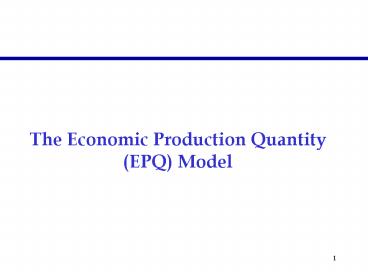The Economic Production Quantity EPQ Model - PowerPoint PPT Presentation
1 / 19
Title:
The Economic Production Quantity EPQ Model
Description:
TP: production cycle (time facility is producing per order cycle) ... Qmax = TP(P - D) = Q(1 - D/P) Average inventory = Qmax/2. Number of orders per unit time = D/Q ... – PowerPoint PPT presentation
Number of Views:753
Avg rating:3.0/5.0
Title: The Economic Production Quantity EPQ Model
1
The Economic Production Quantity (EPQ) Model
2
- Similar assumptions to the EOQ model, except
that production/delivery is not instantaneous - Units are produced and delivered one unit at a
time - Production capacity is finite with a finite
production rate P
3
Notation
- P production rate (number of units/time period)
- TP production cycle (time facility is producing
per order cycle) - TD withdrawal cycle (time facility is idle per
order cycle) - T total inventory cycle (time between setups)
- Qmax maximum inventory level (units)
4
Inventory versus Time
5
- TP Q/P
- TD Qmax/D
- Qmax TP(P - D) Q(1 - D/P)
- Average inventory Qmax/2
- Number of orders per unit time D/Q
6
Costs
- Total holding cost hQmax/2hQ(1-D/P)/2
- Total ordering/setup cost AD/Q
- Total production/purchasing cost cD
- Total cost AD/Q hQ(1 - D/P)/2 cD
- Unit cost A/Q hQ(1 - D/P)/2D c
7
The Economic Production Quantity
8
- The EPQ is equivalent to an EOQ model with
holding cost hh(1-D/P). - Consequently, the optimal cost under the EPQ
model is lower than the optimal cost under the
EOQ model with holding cost h.
9
Production Facility Utilization
- U D/P (capacity utilization)
- We must not operate above capacity (i.e., always
keep U ? 1) - What happens when D gt P?
- What happens when D P?
10
EOQ vs. EPQ
- Q(EPQ) ? Q(EOQ) when U ? 1
- Q(EPQ) Q(EOQ) when U ? 0
- Q(EPQ) ? infinity when U ? 1 (continuous
production) - Y(Q(EPQ)) ? cD when U ? 1
11
Systems with Multiple Products
N number of products Di demand rate for
product i Pi production rate for product i hi
holding cost per unit per unit time for product
i Ai Ordering/setup cost for product i ci
production cost for product i
12
Objective
Minimize total cost while guaranteeing that no
stockouts occur for any product.
13
- In order to ensure feasibility, we must have
- Choosing can
lead to stockouts
14
A Cyclic Policy
- A strictly cyclic policy is used (in each cycle,
there is exactly one setup per product) - Cycle time, T, is the time between two
consecutive setups for any given product - During T, a quantity Qi of each product i is
produced and consumed therefore, Qi DiT
15
Inventory versus Time
P1 P2 P3
Inventory
Time
16
Order Quantities and Order Interval
- Cost for Product i
17
Order Quantities and Order Interval
- Cost for Product i
- Total Cost
18
Order Quantities and Order Interval
- Cost for Product i
- Total Cost
- Since Qi/Di T,
19
Optimal Order Interval and Order Quantities































